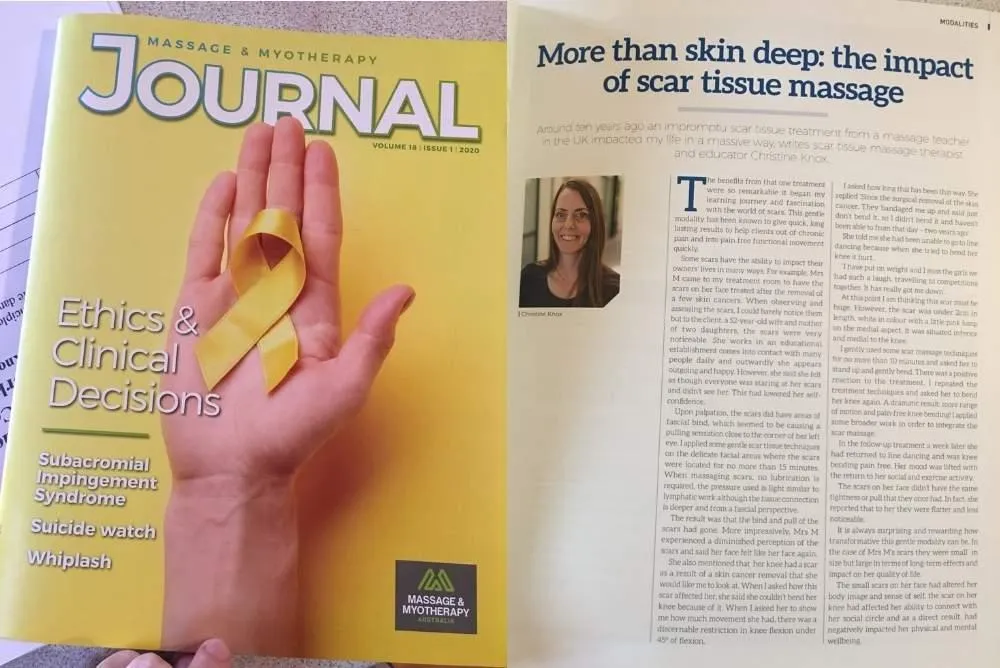
More Than Skin Deep: The impact of Scar Tissue Massage
Around 10 years ago an impromptu scar tissue treatment from a massage teacher in the UK massively impacted my life. The benefits from only one treatment were so remarkable it began my learning journey and fascination with the world of scars.
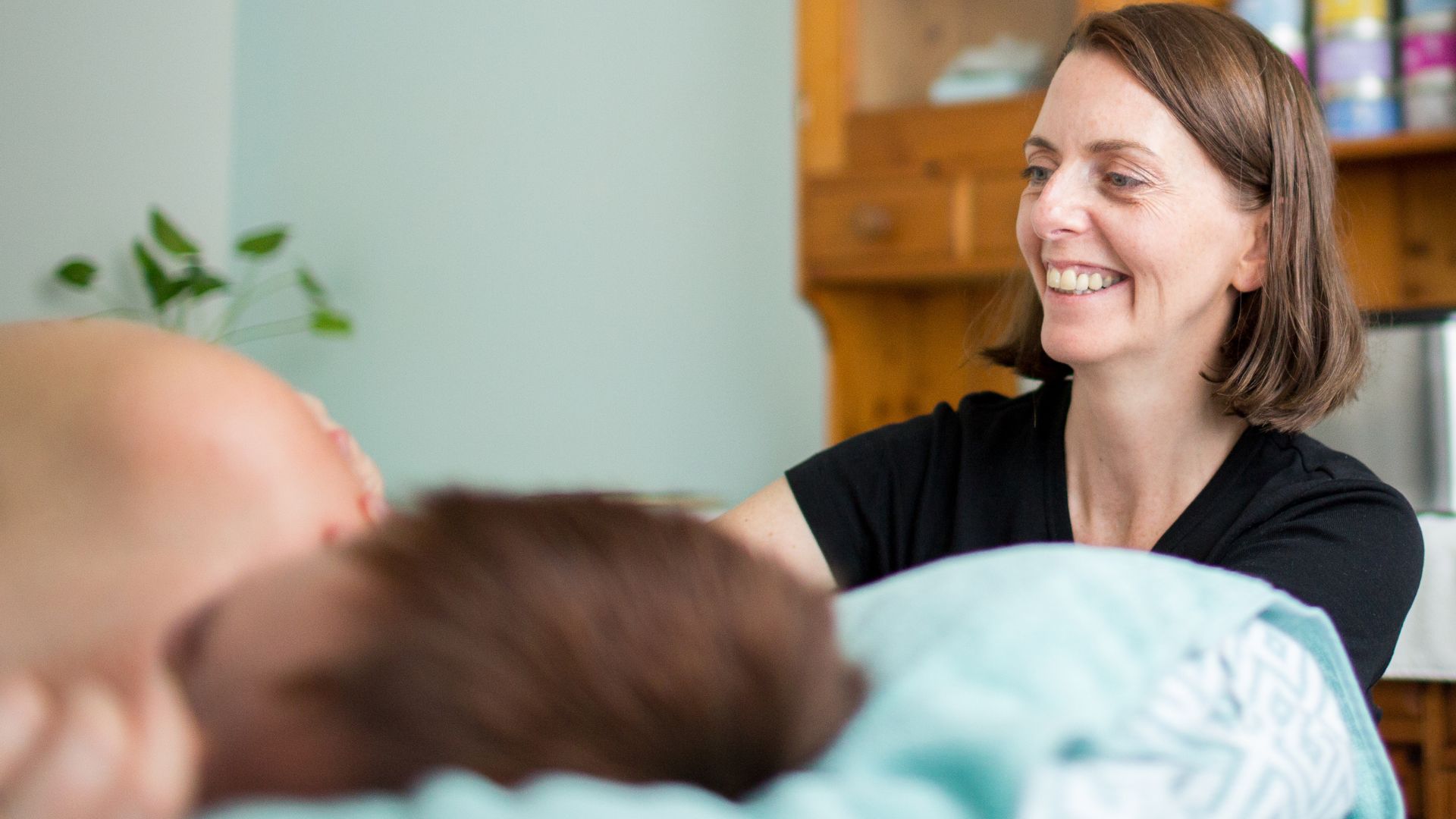
As a Scar Tissue Massage Therapist and Educator with a combination of scar tissue experience and study at my fingertips, I am excited to impact other people’s lives similarly.
This gentle modality has been known to give quick, long-lasting results to help clients out of chronic pain and into pain-free functional movement quickly.
Some scars can impact their owners’ lives in many ways. Let me explain by sharing the story of Mrs. M. who came to my treatment room to have the scars on her face treated after the removal of a few skin cancers. When observing and assessing the scars to be treated I could barely notice them but to the client, a 52-year old female, wife, mother of two daughters. The scars were very noticeable and she told she felt as though everyone was staring at them and in so doing didn’t see her. She went on to say how much this had lowered her self-confidence.
Mrs. M. works within an educational establishment providing administrative support and come into contact with many people on a daily basis outwardly, she appears outgoing and happy. Upon palpation, the scars did have areas of a fascial bind which seemed to be causing a pulling sensation close to the corner of her left eye.
I applied some gentle scar tissue techniques on the delicate facial areas where the scars were located for no more than 15minutes. When massaging scars no lubrication is required the pressure used is light similar to lymphatic work although the tissue connection is deeper and from a fascial perspective.
The result was that the bind and pull of the scars had gone. Perhaps a more impressive impact was that Mrs. M. experienced a diminished perception of the scars being a stand-out feature of her appearance. She said her face felt like her face again.
When we were chatting she also happened to mention her knee had a scar that she would like me to take a look at.
This scar was also a result of skin cancer removal when I inquired how do you think this scar affects you?
She replied that she couldn’t bend her knee because of it. I asked her to show me how much movement she did have, there was a discernible restriction in knee flexion under 45degrees of flexion.
When I asked how long this has been this way, she replied since the surgical removal of the skin cancer. They bandaged me up and said just don’t bend it so I didn’t bend it and haven’t been able to from that day.
How long have you not been able to bend your knee? I asked her.
Two years.
She continued to tell me that she had been unable to go line dancing because when tried to bend her knee it hurt.
“I have put on weight and I miss the girls we had such a laugh, travelling to competitions together. It has really got me down”
So at this point, I was thinking I need to see this scar, it must be huge.
Looking back at my notes this scar was under 2cm in length, white with a little pink lump on the medial aspect, situated inferior and medial to the knee.
I gently used some scar massage techniques for no more than 10 minutes and asked her to stand up and gently bend. I repeat the treatment techniques and ask her to bend her knee again. A dramatic result: more range of motion and pain-free knee bending!
I applied a broader work to integrate the scar massage.
In the follow-up treatment, a week later, she had returned to line dancing and was knee bending pain-free, her mood was lifted with the return to her social and exercise activity.
The scars on her face didn’t have the same tightness or pull that they once had. She reported that the scars were flatter and less noticeable.
It is always surprising and rewarding how transformative this gentle modality can be. In the case of Mrs. M’s scars in size, they were small and large in terms of long-term effects and impact on her quality of life.
The small scars on her face had altered her body image and sense of self, the scar on her knee had affected her ability to connect with her social circle and as a direct result had negatively impacted her physical and mental wellbeing.
Interestingly just because a person has a scar does not mean it will be problematic. In normal healthy circumstances, healing is completed and function is restored to the area.
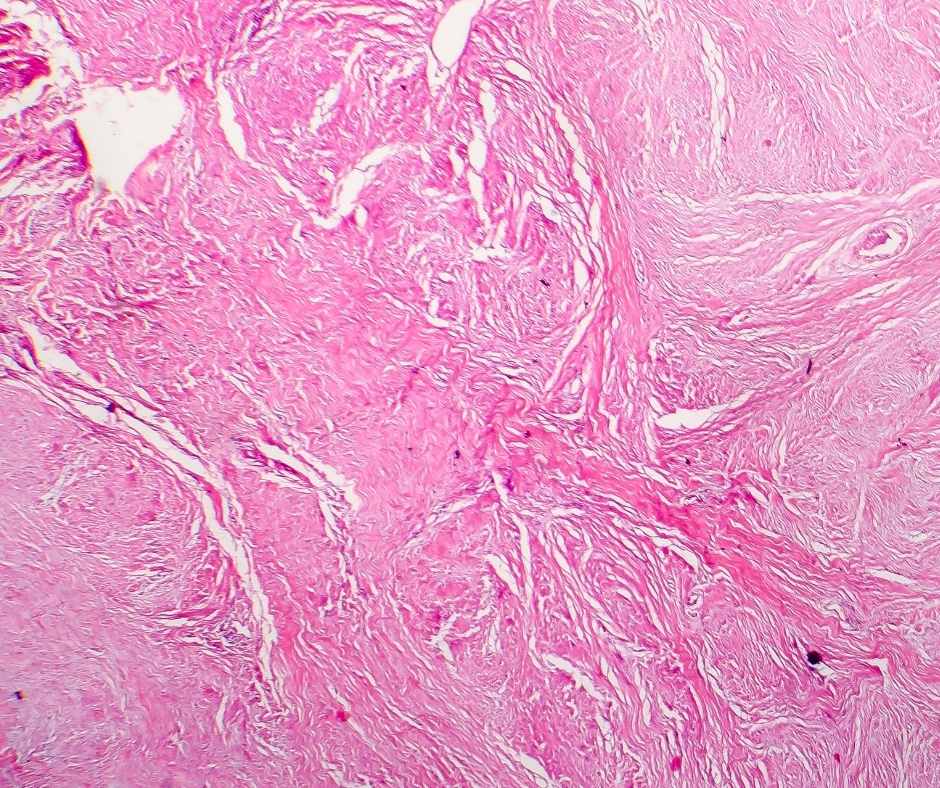
Healing has four precise stages, which overlap: Homeostasis, Inflammation, Proliferation, and Re-modelling.[i]
For successful healing, a wound must go through each stage in the set order for an exact period. The problems occur when a variance to the healing process happens resulting in abnormal scars.
Research has demonstrated that abnormal scars can impact function within and beyond their physical borders and present considerations outside of the physical and physiological aspects of the scar tissue. [ii] [iii]
This means that when scars do behave atypically, there is a possibility of experiencing far-reaching effects to areas distant from the scar, resulting in dysfunction to the biotensegrity of the fascia.
Thinking of an iceberg, what we see on the surface is nothing compared to what is unseen below and beyond what we perceive to be the boundary of the scar.
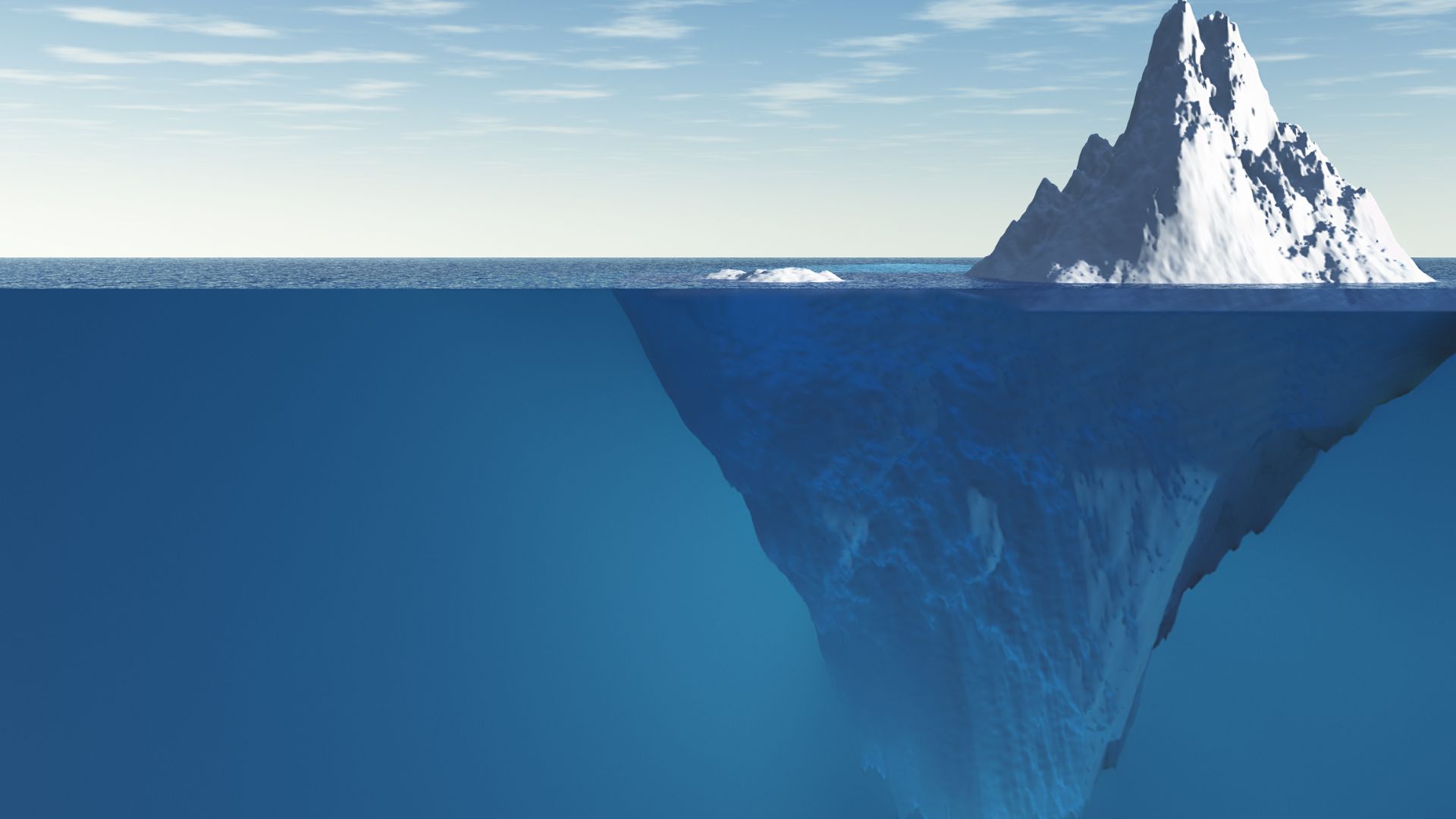
Because scars have the potential to negatively affect nerves, fascia, lymph, and muscles, all of which are within the domain of massage and myotherapists. Scar tissue massage can offer an avenue of potential treatment that most therapists are as yet unaware of. This treatment modality could result in longer-lasting results or even total resolution for clients.
There is evidence to support the claim that manual scar management techniques do positively affect the impact of pain, function, and quality of life.[iv]
The Australian Government AIWH reports that in 2017–18 there were over 2.3 million elective surgeries with an additional 352,000 emergency surgeries performed. [v]
Figures in this report show a growing number of surgical procedures occurring in Australia every year, thus making it more likely that therapists will encounter more clients with scars in the future.

Introducing scar tissue massage into treatments would impact how therapists handle stubborn chronic pain cases. Most therapists encounter clients experiencing chronic pain or dysfunction of movement and most therapists do not consider treating scars.
The majority of the time, the treatment protocols apply to help clients to reduce their aches and pains and restore their movements. Sometimes the treatment outcomes can be disappointingly short-lived with results diminishing from a few hours to weeks.
This disheartening situation can have the therapist doubt their skills and refer to the client, believing another allied health practitioner will get a superior result. I suspect that in many of these cases the client has an abdominal scar. An undisclosed abdominal scar, possibly because they have forgotten about the scar or simply do not think it has anything to do with their low back pain so don’t mention it.
Under those circumstances, I have found scar tissue massage to be beneficial in resolving chronic low back pain in those with abdominal scars.
Scar Tissue Massage techniques aim to impact clients by:
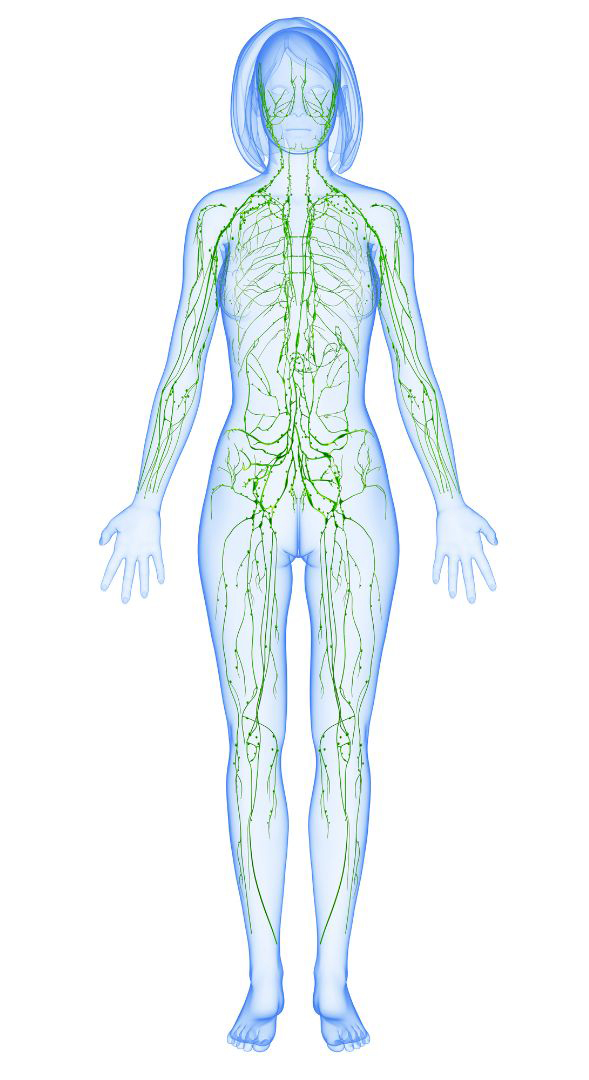
Reducing stress responses in the nervous system increases vascular flow, by increasing lymphatic flow, the aesthetic impact of scars not only minimising but also restoring function addressing fascial restrictions
When working with clients who have experienced trauma the manual therapist does not need to know every detail of the trauma, in order to provide a productive treatment.
In fact, having your client give you a blow-by-blow account of the scar source and subsequent treatment can be detrimental to the outcome of integrating the soft tissue structures. It can bring the injury trauma whether physical or emotional to the surface. It can also affect the therapist by bringing any of their unresolved traumas to the surface too.
This is why grounding and therapeutic boundaries are essential in this modality. Unless otherwise trained massage therapists and myotherapists are not counsellors or psychotherapists, talking therapy is out of our scope of practise.
Luckily for us, being an active and empathic listener is well within our scope of practise.
Skills essential for this work are holding the space, energetic boundaries and compassion to oneself and others.
I have found it helpful to create a network of psychotherapists, councillors, play and music therapists to refer my clients. It also opens the door to reciprocal referrals.
Scar tissue massage can impact the practitioner emotionally. By treating scars therapists are often reminded of their own mortality, the wonderment of the human form, and life itself.
This is why self-grounding and instilling energetic boundaries are essential to this modality. Often the gentle techniques involved in Scar tissue massage can be applied from a seated position, a welcome break for lots of therapists.
Interested in learning more about Scar Tissue Massage?







